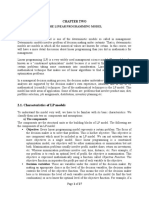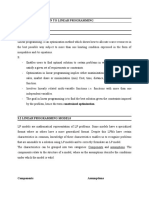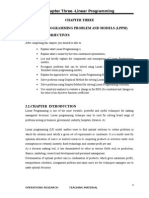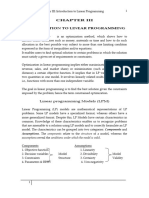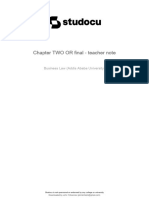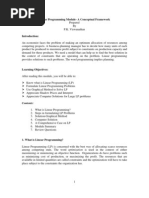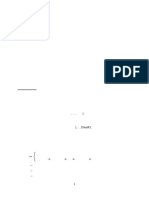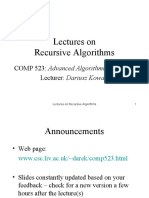0 ratings0% found this document useful (0 votes)
3 viewsOT_Ch_03_Linear Programming
Chapter 3 introduces Linear Programming (LP) as a mathematical optimization technique for decision-making involving linear functions, focusing on maximizing or minimizing objectives subject to constraints. It outlines the components of LP models, including objective functions, decision variables, and constraints, and discusses the assumptions necessary for valid LP models. The chapter also details the formulation of LP problems through examples and describes solution approaches such as the graphic and algebraic (Simplex) methods.
Uploaded by
newaybeyene5Copyright
© © All Rights Reserved
Available Formats
Download as PDF, TXT or read online on Scribd
0 ratings0% found this document useful (0 votes)
3 viewsOT_Ch_03_Linear Programming
Chapter 3 introduces Linear Programming (LP) as a mathematical optimization technique for decision-making involving linear functions, focusing on maximizing or minimizing objectives subject to constraints. It outlines the components of LP models, including objective functions, decision variables, and constraints, and discusses the assumptions necessary for valid LP models. The chapter also details the formulation of LP problems through examples and describes solution approaches such as the graphic and algebraic (Simplex) methods.
Uploaded by
newaybeyene5Copyright
© © All Rights Reserved
Available Formats
Download as PDF, TXT or read online on Scribd
You are on page 1/ 7
Chapter 3
Introduction to Linear Programming
Linear programming involves choosing a course of action when the mathematical model of the problem
contains only linear function.
Linear Programming (LP):- is a problem solving that has been developed to help anyone make decision.
It is a mathematical optimization technique which shows how to allocate scarce resources (financial, human
and material resources).
Optimization: is either maximization of (profit, market share, good well, etc) or minimization of (cost,
risk, loss, time, distance, space etc). Linear programming is also called constrained optimization.
e.g. 3x1 + 2x2 + 7x3 ≤ 250 (Labor constraint) (x1 , x2 & x3 are decision variables)
Linear programming is characterized by an objective function (Of) to be optimized which is subject to
constraints that deficient the availability of resources and other limitations which used in determining
feasible solution region. Finally the objective function will be used to select the best solution.
Linear programming models
LP models (LPM) are mathematical representation of LP problems (LPP). Some models have a specialized
format where as others have a more generalized format. Despite this, LPMs have certain characteristics in
common knowledge of these characteristics enables us to recognize problems that are amenable to a
solution using LP models and to correctly formulate an LP model. The characteristics can be grouped into
two categories: Components and assumptions. The components relate to the structure of a model, whereas
the assumptions describe the conditions under which the model is valid.
Components
1. Objective function
2. Decision variables Model
3. Constraints Structure
4. Parameters and Right.
Hand Side Values
5. Non-negativity
3.2.1 Components of LP Model
a) The Objective function: is the mathematical/ quantitative expression of the objective of the company/
model. The objective in problem solving is the criterion by which all decisions are evaluated. In LPMs
a single quantifiable objective must be specified by the decision maker. For example, the objective
might relate to profits, or costs or market share, best to only one of these. Moreover, because we are
dealing with optimization, the objective will be either maximization or minimization, but not both at a
time
b) The Decision Variables: represent unknown quantities to be resolved for. These decision variables
may represent such things as the:
- number of units of different products to be sold
- the # of dollars to invest in various projects
- the # of ads to place with different media
Since the decision maker has freedom of choice among actions, these decision variables are controllab le
variables.
c) The constraints: are restrictions which define or limit the attainability (achievability) feasibility of a
proposed course of action. They limit the degree to which the objective can be pursued.
A typical restriction embodies scarce resources (such as labor supply, RMs, production capacity, machine
time, storage space), legal or contractual requirements (leg. Product standards, work standards), or they
may reflect other limits based on forecasts, customer orders, company policies etc.
Business Mathematics Lecture Notes and Class Examples of Chapter 3 Page 1 of 7
Constraints has four elements
i) A right hand side (RHS) quantity that specifies the limit for the constraints (RHS = 300, 200, 360,
etc.)
ii) An algebraic sign that indicate whether the limit is upper limit bound “≤”, lower limit bound “≥”
or equal “ = ”
iii) The decision variables to which the constraint applies
iv) Parameter: the impact that one unit of each decision variable will have the (RHS) quantity of the
constraints
d) Parameters- are fixed values that specify the impact that one unit of each decision variable will have
on the objective and on any constraint it pertains to as well as to the numerical value of each constraint.
The components are the building blocks of an LP model. We can better understand their meaning by
examining a simple LP model as follows.
Example: Maximize:
Maximize: 4X1 + 7X2 + 5X3 (profit)… objective function subject to
2X1 + 3X2 + 6X3 300 labor hrs
5X1 + 4X3 200 raw mata. System
3X1 + 5X2 + 2X3 360 Constraints
X1 = 30 Individual
X1 – qty of product 1 X2 40 Constraints
X2 qty of product 2 X1 , X2 , X3 0 Non negativity constructs
Variables
Decision
X3 qty of product 3
System constraints- involve more than one decision variables
Individual constraint- involve only one decision variable.
None-negativity constrains- specify that no variable will be allowed to take on a negative value. The non
negativity constraints typically apply in an LP model, whether they are explicitly stated or not.
Assumptions of Linear Programming Model (LPM)
1) Linearity: it is a requirement that each decision variables a linear impact on objective function and
on each constraint in which it appears.
2) Certainty: it refers to parameters that should be remaining constant at any level and identified
constraints should be as they are at any point.
3) Divisibility: this requirement pertains to the potential values of the decision variables.
4) Non- Negativity: negative values of variables are unrealistic and therefore will not be considered
as a potential solution.
Formulation of Linear Programming Models
Steps in formulating Linear Programming Model (LPM)
Step1: Determine the objective
Maximization or Minimization
Step2: Assign variables to each of unknown quantities for which you wish to solve
Step3: Find the mathematical expression that represent the objective function (Of) in terms of unknowns
just chosen above
Step4: Identify the constraints
Determine the appropriate rules for decision variables
Determine whether an upper limit, lower limit equality called for
Add any additional constraints that are implicit in the nature of the problem
Step5: Summarize the model.
Business Mathematics Lecture Notes and Class Examples of Chapter 3 Page 2 of 7
Formulating the Maximization Problem
E.g.3.1 (Product Mix Problem)
Assume that Philips Company produces two types of TV set called Model A and Model B. The Company
is make money; its objective is to maximize profit. The profit realized from set A&B are Br. 300 per unit
and Br. 250 per unit respectively. The Company wants to produce and sell thousands of sets weekly but
this is not possible due to some limitations. These limitations are;
1. There are only 40 hours of labor available in the production department each week.
2. There are only 45 hours of machine time each week.
3. No more than 12 sets of model A can be sold each week.
It is known that each set of model “A” being in higher quality requires 2 hours of labor hour and each
set of model “B” only require one hour of labor to be produced.
Machine processing time for one unit of model “A” & “B” is one hour and 3 hours respectively.
Required:
a) Describe the problem situation with a linear programming model (LPM)
b) How many set of model A & B should be produced each week using graphic method?
Solution a) Developing Maximization LPM
Step1: Determine the objective
Profit Maximization
Step2: Assign decision variables
Let: X1 = Quantity of TV set Model A
X2 = Quantity of TV set Model B
Step3: Mathematical expression of the objective function (Of)
Profit from model A TV set = 300 br; profit from model B TV set = 250 br
Θmax = 300x 1 + 250x 2
Step4: Identify the constraints
Constraints Products Maximum available
Model A (x 1 ) Model B (x 2 )
Labor hour 2 1 40
Machine hour 1 3 45
2x 1 + x 2 ≤ 40 labor hour constraint
x 1 + 3x 2 ≤ 45 machine hour constraint
x1 ≤ 12 market demand constraint
Step5: Summarize the model.
Θmax = 300x 1 + 250x 2
Subject to:
2x 1 + x 2 ≤ 40
x 1 + 3x 2 ≤ 45
x1 ≤ 12
x1 , x2 ≥ 0
E.g.3.2 (Blending/Combination Problem)
Ready Company owns a small paint factory that produces both exterior and interior house paint for whole
distribution. Two basic raw materials namely raw material A and B are used to manufacture the paints. The
maximum availability of raw material A is 6 tons a week and that of raw material B is 8 tons a week. The
weekly requirements of raw materials per ton of exterior and interior paints are summarized below.
Ton(s) of raw material per ton of paint
Exterior Interior Maximum available of raw material
Raw material A 1 2 6
Raw material B 2 1 8
Business Mathematics Lecture Notes and Class Examples of Chapter 3 Page 3 of 7
A market survey has establish that the weekly demand interior paint cannot exceed exterior paint by more
than 1 ton. The survey also shows that the maximum demand for interior paint is limited to two tons a
week. The whole sale price per ton is 3,000 birr for exterior and birr 2,000 for interior.
Required:
1) Formulate the linear programming model
2) How much exterior and interior paint should produce to maximize the gross income (revenue)
using graphic method?
Formulating the Minimization Problem
E.g.3.3 (A Diet Mix Problem)
Mr. X has learned from nutrition book that is family need at least 330 grams of protein and 45 milligra ms
of iron per day for sound diet. These nutrients can be obtained from meat and vegetable products. Each
pound of meat costs an average of birr 1.6 and contains an average of 150gm of protein and 15mg of iron.
While each pound of vegetable costs birr 0.5 has 10gm of protein and 5mg of iron. X wants to determine
the quantities of food that meet the nutritional requirements of his family at least cost. Required:
a) Formulate the linear programming model
b) Determine the quantities of food that meet its family need at least cost using graphic method
Solution a) Formulating Minimization LPM
Step1: Determine the objective
Cost Minimization
Step2: Assign decision variables
Let: X1 = Quantity of Meat in pound
X2 = Quantity of Vegetable in pound
Step3: Mathematical expression of the objective function (Of)
Cost from Meat = 1.6 br/pound; Cost from Vegetable = 0.5 br/pound
Θmin = 1.6x 1 + 0.5x 2
Step4: Identify the constraints
Constraints Food items Maximum
Meat (x 1 ) Vegetable (x 2 ) available
Protein 150gm 10gm 330gm
Iron 15mg 5mg 45mg
150x 1 + 10x 2 ≥ 330 protein constraint
15x 1 + 5x 2 ≥ 45 iron constraint
Step5: Summarize the model.
Θmin = 1.6x 1 + 0.5x 2
Subject to: 150x 1 + 10x 2 ≥ 330
15x 1 + 5x 2 ≥ 45
x1 , x2 ≥ 0
E.g.3.4 (A Diet Mix Problem)
A dietitian explains the menu for the evening meal at University hall two main items will be served each
having different nutritional content. The dietician is interested in provide at least the minimum daily
requirements of each of the three vitamins in the meal. The table below summarizes the vitamin content
per ounce of each food. The cost per ounce of the meal and minimum daily levels for the three vitamins.
Vitamins
Food Item Vitamin 1 Vitamin 2 Vitamin 3 Cost/Ounce
Food 1 50mg 20mg 10mg 0.1 birr
Food 2 30mg 10mg 50mg 0.5 birr
Minimum daily vitamin requirement 290mg 200mg 210mg
Determine the number of ounces of each food to be induced in the meal that minimize the cost and at the
same time that can satisfy the minimum daily levels of the three vitamins.
Business Mathematics Lecture Notes and Class Examples of Chapter 3 Page 4 of 7
Solution Approaches to Linear Programming Problem
There are two approach of solving linear programming models. These are
Graphic Approach
Algebraic (Simplex) Approach
Graphic Approach
The graphic approach gives a visual portrayal (description) of many important concepts of Linear
Programming Model (LPM) and it is used only when the decision variables are two. Steps in graphic
solution
Step1: Formulate Linear Programming Model
Step2: Draw the graph and identify corners
Step3: Identify the feasible solution space/region. It is the shaded region tha simultaneously satisfy all the
constraints.
Step4: Identify the feasible region points that satisfy the constraints simultaneously in LPM.
Step5: Evaluate the objective function against the feasible solutions.
Step6: Find the optimum solution
The maximum value in the case of maximization
The minimum value in the case of minimization.
Graphic solution for Maximization LPM E.g. 3.1 and E.g.3.2
Graphic solution for Minimization LPM E.g. 3.3
Algebraic (Simplex) Approach
Simplex Method: is an iteration (step by step) ways of getting an optimum solution to linear programming
problem it starts to the smallest corner that is in the solution space the moves to another corner that
improves the objective function.
Basic Solutions
Solution which represent interaction of constraints which can be basic feasible solution and basic
infeasible solution. Basic feasible solutions are solutions which satisfies all constraints includ ing
non-negativity.
A simplex procedure or a maximization problem with all less than or equals to constraints consists of
the following steps.
Step1: Write the linear programming model in standard form
When all constraints are written as equalities, the linear programming model is said to be in standard
form.
For maximization problems a given LPM is changed in to in standard form by applying slack variables
(variables representing unused scarce resources) S i which carries the subscript which applies to denotes
(S1 , S2 , S3 , …, Sn ). the coefficient of slack variables is zero in the objective function and one in the
constraints.
Step2: Develop initial tableau
The initial tableau always represents the “do nothing strategy” so, that the decision variables are
initially non basic.
Basic Variables are variables which have in solution (slack basic variables for initial tableau)
Non basic variables: are variables which are not in the solution (decision variables are non basic
variables at initial tableau)
a) List the variables across the top of the table and write the objective function coefficient of each
variable below it.
b) There should be one row in the body of the table for each constraint. List the slack variables in the
basic column.
c) Compute values for Zj row. The row Zj values are determined by column by column and it obtained
by multiplying the coefficient of basis by respective column numbers.
d) Compute values for row Cj-Zj. These values can be determined by subtracting Zj from Cj rows.
Note: Decision variables that are in solution zero appear in the bottom of the tableau.
Business Mathematics Lecture Notes and Class Examples of Chapter 3 Page 5 of 7
The values in the bottom row (Cj-Zj) indicate any potential improvement.
General Rule: a Simplex solution in maximization problem is optimal if Cj –Zj row consists initially zero
and negative numbers (if there are no positive numbers in the bottom row.
Step3:- Develop the subsequent tableau
Develop the second tableau
a) Identify the entering variable:- it is a variable that has the largest positive value in the Cj-Zj row.
b) Identify the leaving variable:- it is the one which has the smallest non-negative ratio of Right
Hand Said (RHS) value divided by the substitution rate in the entering variable column.
The top row of the objective function is unchanged but to develop the next tableau, we must compute
three sets of values.
1. Revised constraint coefficient
2. Revised for Zj row
3. Revised for Cj-Zj row.
c) Find unit vector for the new basic variables using row operations. Then change pivot element in to
one and using this number change the other pivot column in to zeros. Repeat the above steps until
you reach the optimal point.
E.g.3.5 max = 60x1 + 50x2
Subject to (St):
4x1 + 10x2 ≤ 100
2x1 + x2 ≤ 22
3x1 + 3x2 ≤ 39
x1 , x2 ≥ 0
E.g.3.6 A farmer own a 100 acre farm and plus two plant at most three croups. The seed for croup a, b and
c costs Br. 40, Br. 20 and Br. 30 per acre respectively. A maximum of Br. 3,200 can spent on seed croups
a, b & c required 1, 2, & 1 work days per acre respectively and there are a maximum of 160 work days
available. If the farmer can make a profit of Br. 100, Br. 300 and Br. 200 per acre of croup a, b & c
respectively. How many acres of each croup should be planted to maximize profit.
Minimization by Maximization the Dual
In this section we shall learn how to change a minimization problem with ≥ constraints into a maximiza tio n
problem with ≤ constraint; so, that the solution method already developed can be applied to either type of
problem. Thus, we shall solve a “less than or equal to max or min by the methods already shown, but
change a greater than or equal to min” to a “less than or equal to max” and then solve by the method already
shown.
The original “greater than or equal to min” will be called the primal problem. The less than or equal to
max to which we change will be called the dual problem.
The following steps are important to change the Primal to Dual
Step1: Rewrite the primal for ease of manipulation with the non negativity constraints first and the
objective function last.
Step2: Attaching the column of X1 coefficient to P1, P2 ; the same to attaching the column of X2 coeffic ie nt
to P1 , P2 and using min coefficient in the X1 column as the constraint for the first equation, the same to in
the X2 column as min coefficient taken as the constraint for the second equation.
Finally the new objective function is formed in a similar manner from the right hand column of
constraints
E.g.3.7 How change the Primal to Dual
min = 2X1 + 3X2
Subject to (St):
3X1 + 2X2 ≥ 12
7X1 + 2X2 ≥ 20
X1 , X2 ≥ 0
Business Mathematics Lecture Notes and Class Examples of Chapter 3 Page 6 of 7
Solution
Step1: Rewrite the primal for ease of Step2: Attaching the column of X1 coefficient to
manipulation, the non-negativity constraint first P1 , P2 the same to attaching the column of X2
and the objectives function last. coefficient to P1 , P2 and using min coefficient in
Primal the X1 column as the constant for the first (1 st )
X1 , X2 ≥ 0 equation, the same to in the X2 column as min
P1 : 3X1 + 2X2 ≥ 12 coefficient taken as the constant for the second
P2 : 7X1 + 2X2 ≥ 20 (2nd) equation.
min = 2X1 + 3X2 Finally the new objective function is formed in a
Where: P1 & P2 are surplus variables similar manner from the right hand column of
constants
The dual problem is
max : 12P1 + 20P2
Subject to: 3P1 + 7P2 ≤ 2
2P1 + 2P2 ≤ 3
P1, P2 ≥
E.g.3.8 A diet is to contain at least 10 Ounce of nutrients of nutrient R, 12 ounce of nutrient S and 20
ounces of nutrient T. These nutrients are to be obtained by some combination of food A, B & C. Each
pound of A costs 4 cents and has 4 ounce of R, 3 ounce of S and no ounce of T. Each pound of B costs 7
cents and has 1 ounce of R, 2 ounce of S and 4 ounce of T. Each pound of C costs 5 cents and has no ounce
of R, 2 ounce of S and 5 ounce of T. how many pounds of A, B & C should be combined to provide the
required amount of nutrient at minimum cost?
Solution
Step1: Determine the objective Step5: Summarize the model
Minimization Where: P1 , P2 & P3 are surplus variables in the
Step2: Assign decision variables primal and X1 , X2 & X3 will become slack
Let: X1 : = The number of pounds of food A variables in the dual
X2 : = The number of pounds of food B Dual form: max : 10P1 + 12P2 + 20P3
X3 : = The number of pounds of food C Subject to: X1 : 4P1 + 3P2 ≤4
Step3: Find the mathematical expression of the X2 : P1 + 2P2 + 4P3 ≤ 7
Objective Function X3 : P2 + 5P3 ≤ 5
min = 4X1 + 7X2 + 5X3 P1 , P 2 , P 3 ≥ 0
Step4: Identify constraints Introducing X1 , X2 & X3 as slack, we change the
P1 : 4X1 + X2 ≥ 10 (Nutrient R constraints and the objective function to.
constraints) 4P1 + 3P2 + 0 + X1 + 0 + 0
P2 : 3X1 + 2X2 + X3 ≥ 10 (Nutrient S P1 + 2P2 + 4P3 + 0 + X2 + 0
constraints) 0 + P2 + 5P3 + 0 + 0 + X3
P3 : 4X2 + X3 ≥ 20 (Nutrient T max : 10P1 + 12P2 + 20P3 + 0 + 0 + 0
constraints)
X1 , X2 , X3 ≥ 0
Final answer; the minimum cost: X1 = 8/3 pound of food A
X2 = 0 pounds of food B
X3 = 4 pounds of food C
Business Mathematics Lecture Notes and Class Examples of Chapter 3 Page 7 of 7
You might also like
- CHAPTER III Introduction to Linear ProgrammingNo ratings yetCHAPTER III Introduction to Linear Programming17 pages
- Chapter Two Introduction To Linear ProgrammingNo ratings yetChapter Two Introduction To Linear Programming62 pages
- Chapter 2 Part I - Linear Programming - 102936No ratings yetChapter 2 Part I - Linear Programming - 10293627 pages
- Unit 3: Introduction To Linear ProgrammingNo ratings yetUnit 3: Introduction To Linear Programming12 pages
- Linear Programming Module - A Conceptual FrameworkNo ratings yetLinear Programming Module - A Conceptual Framework25 pages
- Unit Three Intro. to Linear Programming 1No ratings yetUnit Three Intro. to Linear Programming 118 pages
- 1.2 Linear Programming: Model Formulation and Graphical SolutionNo ratings yet1.2 Linear Programming: Model Formulation and Graphical Solution10 pages
- CH 2-1 Linear PP Introduction and Graphic MethodNo ratings yetCH 2-1 Linear PP Introduction and Graphic Method25 pages
- Linear Programming Basic Concepts and Graphical SolutionsNo ratings yetLinear Programming Basic Concepts and Graphical Solutions7 pages
- CHAPTER 9 Auditing Computerized Accounting SystemsNo ratings yetCHAPTER 9 Auditing Computerized Accounting Systems9 pages
- OL-RPG_2_Financial_Statement_Discussion_and_Analysis_July_26_2013No ratings yetOL-RPG_2_Financial_Statement_Discussion_and_Analysis_July_26_201313 pages
- OL_2. FM II CH 2-Divedend policy and theoryNo ratings yetOL_2. FM II CH 2-Divedend policy and theory50 pages
- OL-RPG-3-Reporting-Service-Performance-InformationNo ratings yetOL-RPG-3-Reporting-Service-Performance-Information31 pages
- Weekend Chp 4 Support Department Cost Allocations Test bankNo ratings yetWeekend Chp 4 Support Department Cost Allocations Test bank35 pages
- FM-I Chap. 5&6 Last for Finances and Accounting (1)No ratings yetFM-I Chap. 5&6 Last for Finances and Accounting (1)134 pages
- A Gentle Introduction To Graph Neural NetworksNo ratings yetA Gentle Introduction To Graph Neural Networks9 pages
- Wavelets and Filter Banks: 4C8 Integrated Systems DesignNo ratings yetWavelets and Filter Banks: 4C8 Integrated Systems Design41 pages
- Ec 7005 1 Information Theory and Coding Dec 2020No ratings yetEc 7005 1 Information Theory and Coding Dec 20203 pages
- Using MATLAB For Vibration MeasurementsNo ratings yetUsing MATLAB For Vibration Measurements12 pages
- Optimization Module For Abaqus/CAE Based On Genetic AlgorithmNo ratings yetOptimization Module For Abaqus/CAE Based On Genetic Algorithm1 page
- Image Clustering: Prof. Dr. Rafiqul Islam Department of CSENo ratings yetImage Clustering: Prof. Dr. Rafiqul Islam Department of CSE26 pages
- NTF - Design - For - Coeffiecents - in Practical - OTA - Systematic - Design - Centering - of - Continuous - Time - Oversampling - ConvertersNo ratings yetNTF - Design - For - Coeffiecents - in Practical - OTA - Systematic - Design - Centering - of - Continuous - Time - Oversampling - Converters5 pages
- Lecture 2: Lower Bounds For Randomized AlgorithmsNo ratings yetLecture 2: Lower Bounds For Randomized Algorithms10 pages
- Lectures On Recursive Algorithms: COMP 523: Advanced Algorithmic Techniques Lecturer: Dariusz KowalskiNo ratings yetLectures On Recursive Algorithms: COMP 523: Advanced Algorithmic Techniques Lecturer: Dariusz Kowalski48 pages
- The YUV420 Planar Image Format.: Color Space Luma ChrominanceNo ratings yetThe YUV420 Planar Image Format.: Color Space Luma Chrominance4 pages
- Linear Programming Module - A Conceptual FrameworkLinear Programming Module - A Conceptual Framework
- 1.2 Linear Programming: Model Formulation and Graphical Solution1.2 Linear Programming: Model Formulation and Graphical Solution
- Linear Programming Basic Concepts and Graphical SolutionsLinear Programming Basic Concepts and Graphical Solutions
- Random Optimization: Fundamentals and ApplicationsFrom EverandRandom Optimization: Fundamentals and Applications
- CHAPTER 9 Auditing Computerized Accounting SystemsCHAPTER 9 Auditing Computerized Accounting Systems
- OL-RPG_2_Financial_Statement_Discussion_and_Analysis_July_26_2013OL-RPG_2_Financial_Statement_Discussion_and_Analysis_July_26_2013
- OL-RPG-3-Reporting-Service-Performance-InformationOL-RPG-3-Reporting-Service-Performance-Information
- Weekend Chp 4 Support Department Cost Allocations Test bankWeekend Chp 4 Support Department Cost Allocations Test bank
- FM-I Chap. 5&6 Last for Finances and Accounting (1)FM-I Chap. 5&6 Last for Finances and Accounting (1)
- Wavelets and Filter Banks: 4C8 Integrated Systems DesignWavelets and Filter Banks: 4C8 Integrated Systems Design
- Optimization Module For Abaqus/CAE Based On Genetic AlgorithmOptimization Module For Abaqus/CAE Based On Genetic Algorithm
- Image Clustering: Prof. Dr. Rafiqul Islam Department of CSEImage Clustering: Prof. Dr. Rafiqul Islam Department of CSE
- NTF - Design - For - Coeffiecents - in Practical - OTA - Systematic - Design - Centering - of - Continuous - Time - Oversampling - ConvertersNTF - Design - For - Coeffiecents - in Practical - OTA - Systematic - Design - Centering - of - Continuous - Time - Oversampling - Converters
- Lectures On Recursive Algorithms: COMP 523: Advanced Algorithmic Techniques Lecturer: Dariusz KowalskiLectures On Recursive Algorithms: COMP 523: Advanced Algorithmic Techniques Lecturer: Dariusz Kowalski
- The YUV420 Planar Image Format.: Color Space Luma ChrominanceThe YUV420 Planar Image Format.: Color Space Luma Chrominance







